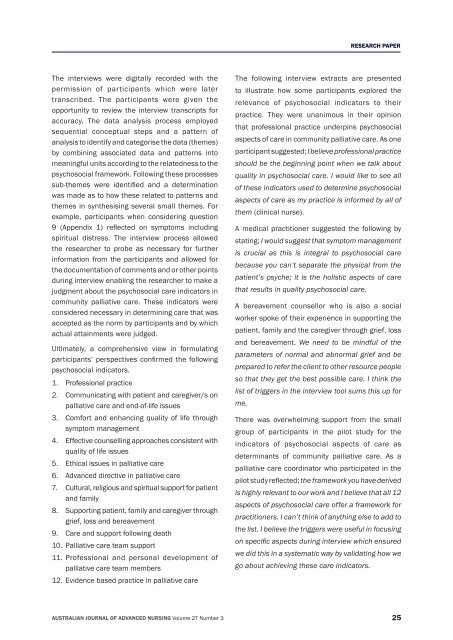March-May, 2010 - Australian Journal of Advanced Nursing
March-May, 2010 - Australian Journal of Advanced Nursing
March-May, 2010 - Australian Journal of Advanced Nursing
You also want an ePaper? Increase the reach of your titles
YUMPU automatically turns print PDFs into web optimized ePapers that Google loves.
RESEARCH PAPER<br />
The interviews were digitally recorded with the<br />
permission <strong>of</strong> participants which were later<br />
transcribed. The participants were given the<br />
opportunity to review the interview transcripts for<br />
accuracy. The data analysis process employed<br />
sequential conceptual steps and a pattern <strong>of</strong><br />
analysis to identify and categorise the data (themes)<br />
by combining associated data and patterns into<br />
meaningful units according to the relatedness to the<br />
psychosocial framework. Following these processes<br />
sub‐themes were identified and a determination<br />
was made as to how these related to patterns and<br />
themes in synthesising several small themes. For<br />
example, participants when considering question<br />
9 (Appendix 1) reflected on symptoms including<br />
spiritual distress. The interview process allowed<br />
the researcher to probe as necessary for further<br />
information from the participants and allowed for<br />
the documentation <strong>of</strong> comments and or other points<br />
during interview enabling the researcher to make a<br />
judgment about the psychosocial care indicators in<br />
community palliative care. These indicators were<br />
considered necessary in determining care that was<br />
accepted as the norm by participants and by which<br />
actual attainments were judged.<br />
Ultimately, a comprehensive view in formulating<br />
participants’ perspectives confirmed the following<br />
psychosocial indicators.<br />
1. Pr<strong>of</strong>essional practice<br />
2.<br />
3.<br />
4.<br />
5.<br />
6.<br />
7.<br />
8.<br />
9.<br />
Communicating with patient and caregiver/s on<br />
palliative care and end‐<strong>of</strong>‐life issues<br />
Comfort and enhancing quality <strong>of</strong> life through<br />
symptom management<br />
Effective counselling approaches consistent with<br />
quality <strong>of</strong> life issues<br />
Ethical issues in palliative care<br />
<strong>Advanced</strong> directive in palliative care<br />
Cultural, religious and spiritual support for patient<br />
and family<br />
Supporting patient, family and caregiver through<br />
grief, loss and bereavement<br />
Care and support following death<br />
10. Palliative care team support<br />
11. Pr<strong>of</strong>essional and personal development <strong>of</strong><br />
palliative care team members<br />
12. Evidence based practice in palliative care<br />
The following interview extracts are presented<br />
to illustrate how some participants explored the<br />
relevance <strong>of</strong> psychosocial indicators to their<br />
practice. They were unanimous in their opinion<br />
that pr<strong>of</strong>essional practice underpins psychosocial<br />
aspects <strong>of</strong> care in community palliative care. As one<br />
participant suggested; I believe pr<strong>of</strong>essional practice<br />
should be the beginning point when we talk about<br />
quality in psychosocial care. I would like to see all<br />
<strong>of</strong> these indicators used to determine psychosocial<br />
aspects <strong>of</strong> care as my practice is informed by all <strong>of</strong><br />
them (clinical nurse).<br />
A medical practitioner suggested the following by<br />
stating; I would suggest that symptom management<br />
is crucial as this is integral to psychosocial care<br />
because you can’t separate the physical from the<br />
patient’s psyche; it is the holistic aspects <strong>of</strong> care<br />
that results in quality psychosocial care.<br />
A bereavement counsellor who is also a social<br />
worker spoke <strong>of</strong> their experience in supporting the<br />
patient, family and the caregiver through grief, loss<br />
and bereavement. We need to be mindful <strong>of</strong> the<br />
parameters <strong>of</strong> normal and abnormal grief and be<br />
prepared to refer the client to other resource people<br />
so that they get the best possible care. I think the<br />
list <strong>of</strong> triggers in the interview tool sums this up for<br />
me.<br />
There was overwhelming support from the small<br />
group <strong>of</strong> participants in the pilot study for the<br />
indicators <strong>of</strong> psychosocial aspects <strong>of</strong> care as<br />
determinants <strong>of</strong> community palliative care. As a<br />
palliative care coordinator who participated in the<br />
pilot study reflected; the framework you have derived<br />
is highly relevant to our work and I believe that all 12<br />
aspects <strong>of</strong> psychosocial care <strong>of</strong>fer a framework for<br />
practitioners. I can’t think <strong>of</strong> anything else to add to<br />
the list. I believe the triggers were useful in focusing<br />
on specific aspects during interview which ensured<br />
we did this in a systematic way by validating how we<br />
go about achieving these care indicators.<br />
AUSTRALIAN JOURNAL OF ADVANCED NURSING Volume 27 Number 3 25

















